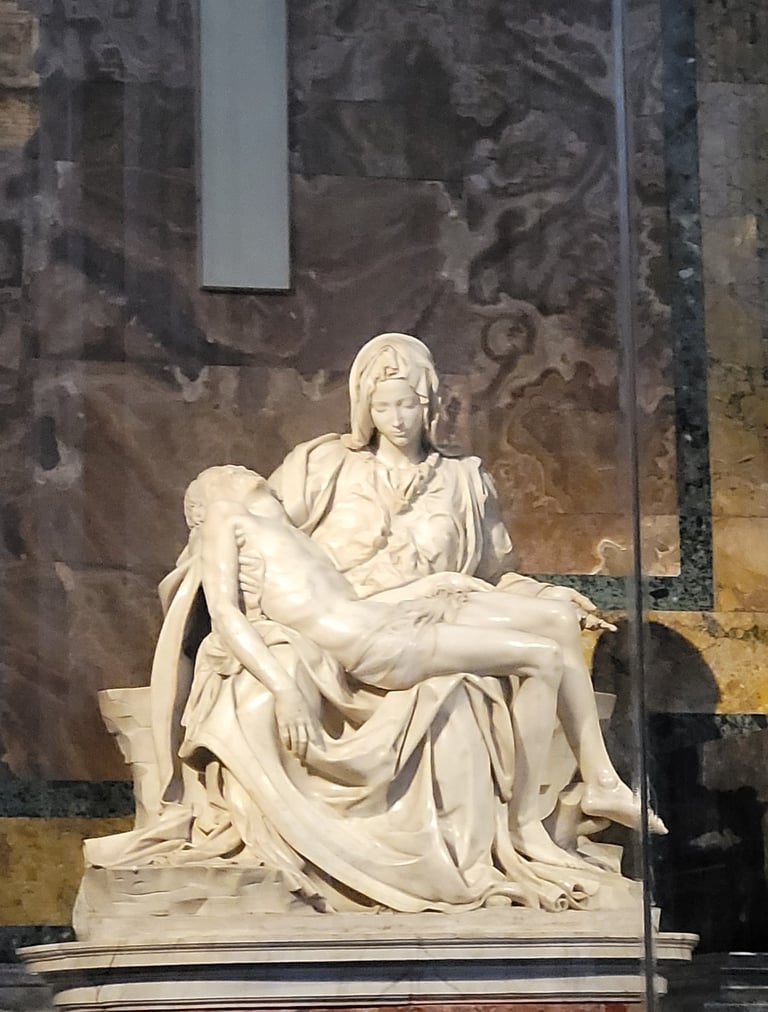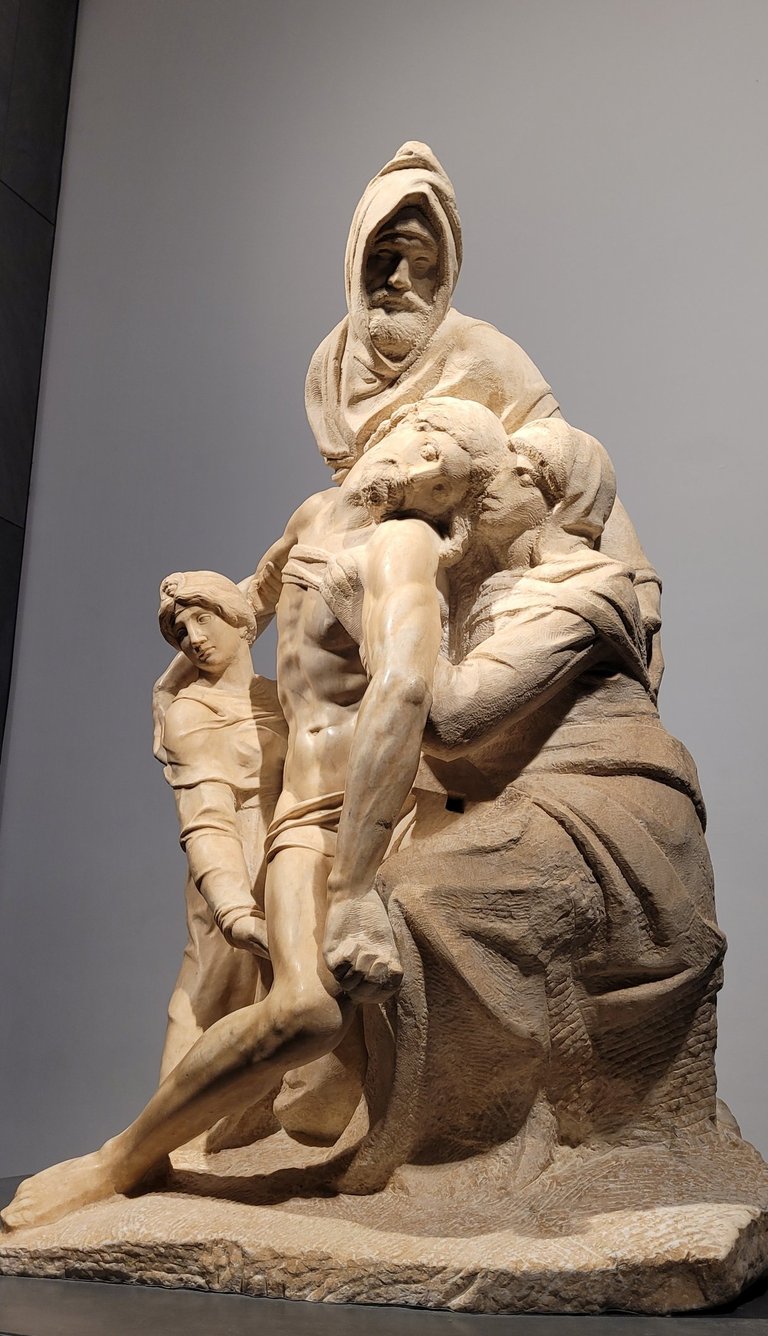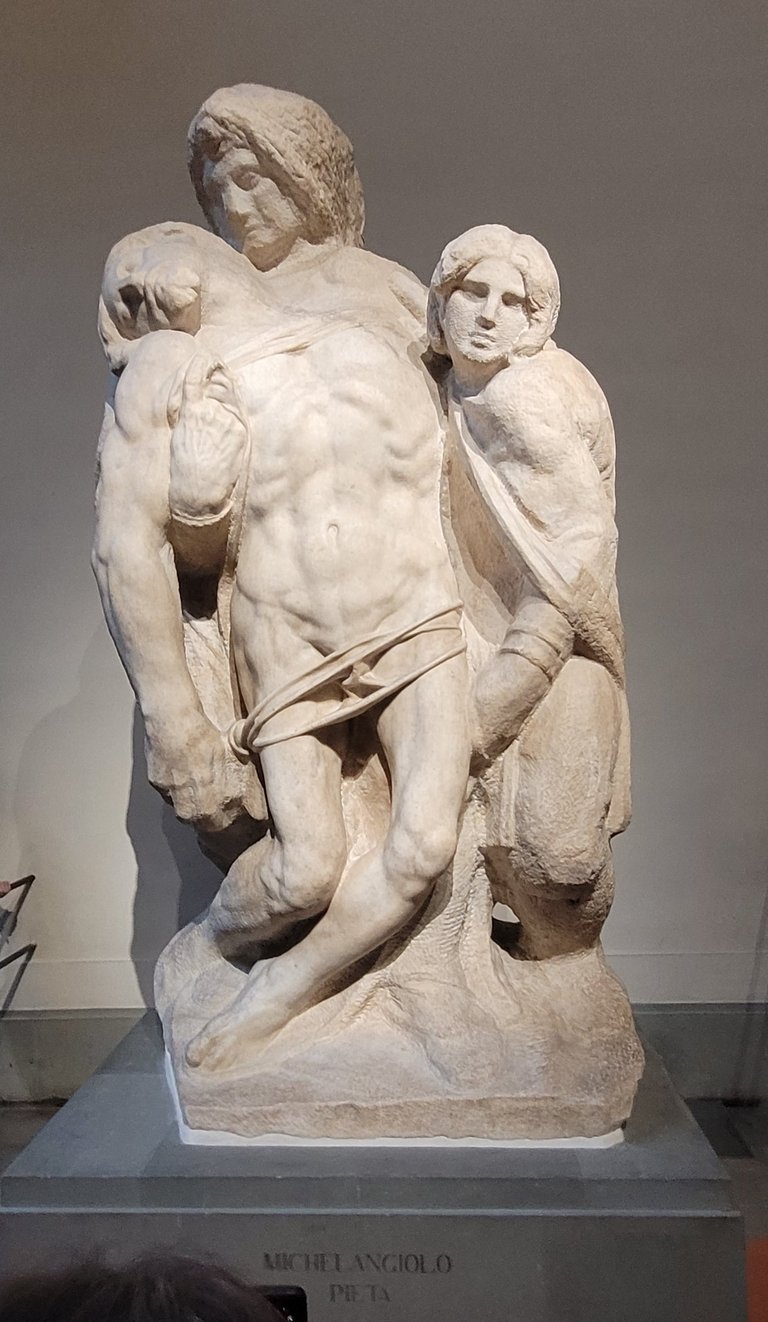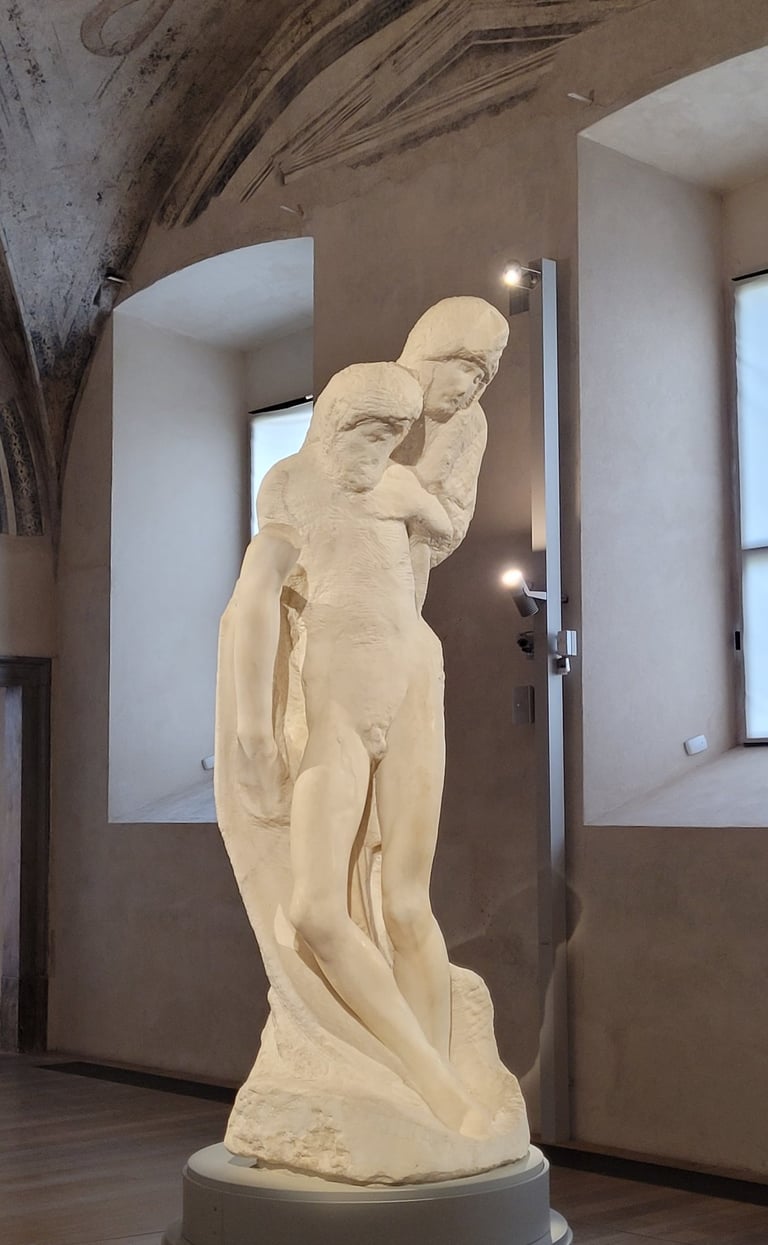The 4 "Pieta"s by Michelangelo
Most people have seen the image of Michelangelo's masterpiece "Pieta" - a marble sculpture depicting Virgin Mary sorrowfully holding the body of her dead son Jesus Christ . Do you know there are 3 other Pietas that Michelangelo created later in life? During my trips to Italy in 2024 and 2025, I was determined to find all of them. I am so thrilled that I did! Here is a brief summary of these sculptures by the master himself, and the photos I took at each of the display locations.
Ting Lu
9/29/2025
Michelangelo created at least three marble Pietàs. Of course the most famous is his first one created when he was only 23. His other significant Pietàs are the Bandini Pietà (also known as the Florentine Pietà or The Deposition) with 4 people - one of them is himself. It was created with the intention to be placed for his own tomb. The last one is the Rondanini Pietà, which was unfinished at the time of his death and is located in the Castello Sforzesco in Milan.
One suspected to be his, the Paletrini Pieta, is now attributed to a different artist - Niccolò Menghini. However some may still consider it came from the hands of Michelangelo.
The images below are in chronological order by the time it was created. You can see the aesthetic changes over time. The "incompleteness" of the sculptures to some may be intentional by the master to reflect his spiritual growth, or perhaps impacted by his physical ability due to old age.
1. Vatican Pietà (Vatican)
Current Location: St. Peter's Basilica, the Vatican
The Vatican Pietà, obviously the most famous of all Michelangelo‘s Pietàs. This iconic marble sculpture depicts the Virgin Mary sorrowfully holding the body of her dead son, Jesus Christ, on her lap.
Michelangelo made Mary's body larger to support the weight of Christ. The sculpture is noted for its technical precision and the idealized beauty of both figures.
It is the only work Michelangelo ever signed and is considered a masterful expression of artistic harmony and technical skill. The signature can be found across Virgin Mary’s chest but Michelangelo later regretted the vanity of this act and resolved never to sign another piece of his work.
The statue was commissioned by the French Cardinal Jean de Bilhères. It was made for the cardinal’s funeral monument but was moved to its current location, the first chapel on the right as one enters the basilica, in the 18th century.
What may be weird for us now, Madonna is represented as being way too young for the mother of a 33-year-old son, which is not uncommon in depictions of her at the time of the Passion of Christ. Various explanations have been suggested for this. One is that her youth symbolizes her incorruptible purity. Michelangelo was only 23 years old when he created this sculpture.


Photo taken on April 16, 2024, St. Peter's Basilica, The Vatican
2. Bandini Pietà (Florence)
Current Location: Museo dell'Opera del Duomo, Florence
It's also known as the "Deposition" or "Florentine Pietà" due to its location.
Michelangelo created this work between 1547 and 1555. The subject is Christ, recently removed from the cross.
In this Pietà we have four figures: the dead body of Jesus Christ, just taken down from the Cross, Nicodemus (or possibly Joseph of Arimathea) towering over him, Mary Magdalene on the side, and the Virgin Mary holding him behind. The face of Nicodemus under the hood is considered to be a self-portrait of Michelangelo himself.
According to famous art historian Giorgio Vasari, Michelangelo made this sculpture to decorate his tomb in Santa Maria Maggiore in Rome. But it now can be found in Florence.
Vasari also noted that Michelangelo began to work on the sculpture around the age of 72. Without commission, Michelangelo worked tirelessly into the night with just a single candle to illuminate his work.
After 8 years of working on the piece, Michelangelo would go on and attempt to destroy the work in a fit of frustration, perhaps due to the flaws of the marble. This marked the end of Michelangelo’s work on the piece and from there the piece found itself in the hands of Francesco Bandini, who hired an apprentice sculptor, by the name of Tiberius Calcagni, to restore the work to its current condition.
Since its inception, the piece has been plagued by ambiguities and never-ending interpretations, with no straightforward answers available.


Photo taken on September 10, 2025, The Duomo, Florence
3. Palestrina Pieta (Florence)
Current Location: Galleria dell'Accademia, Florence
Some sources indicate this Pietà was made in 1556. It was attributed to Michelangelo for the first time in 1756 without any proven evidence. There is no earlier discussion of the work as there is for nearly all others attributed to the master.
Now it is mostly considered to have been completed by Niccolò Menghini or Gian Lorenzo Bernini, but some art historians still claim it was created by the artist himself.
This Pietà depicts three figures - the body of Jesus Christ, Virgin Mary (standing behind Jesus), and Mary Magdalene (on the side).
The sculpture was originally in a room beside the Santa Rosalia church in Palestrina and was owned by the Barberini family. It was was acquired by the government in 1939.


Photo taken on September 10, 2025, Accademia Florence
4. Rondanini Pietà (Milan)
Current Location: Sforzesco Castle, Milan
Michelangelo worked on Rondanini Pietà from the 1550s until the last days of his life, in 1564. It offers insight into Michelangelo's creative process in his later years until his death.
The work was found in his home in Rome but all traces of it were lost for many years until it reappeared in the home of the Marquis Giuseppe Rondinini (this is the correct spelling of the name), a distinguished Roman collector.
Michelangelo hacked at the marble block until only the dismembered right arm of Christ survived from the sculpture as originally conceived.
The spectral Virgin and Christ are different from the idealized figures that exemplified the sculptor’s earlier style and have been said to bear more of a resemblance to the attenuated figures of Gothic sculpture than those of the Renaissance.
It has also been suggested that the sculpture should not be considered unfinished, but a work in a continuous process of being made visible by the viewer as he or she moves around to see it from multiple angles.
When viewing the sculpture from certain rear angles, it looks as if Jesus is holding Mary up with his back, instead of Mary cradling Jesus.
It is said that Michelangelo carefully crafted it this way to represent how Jesus’s spirit might actually have been comforting Mary in her loss.


Photo taken on September 9, 2025, Castello Sforzesco Milan
Custom order? Questions?
Please contact me
ms.ting.lu@gmail.com
678-404-8084
In-person Classes & Workshops held in Ting Lu Design Studio in Alpharetta, GA 30022
